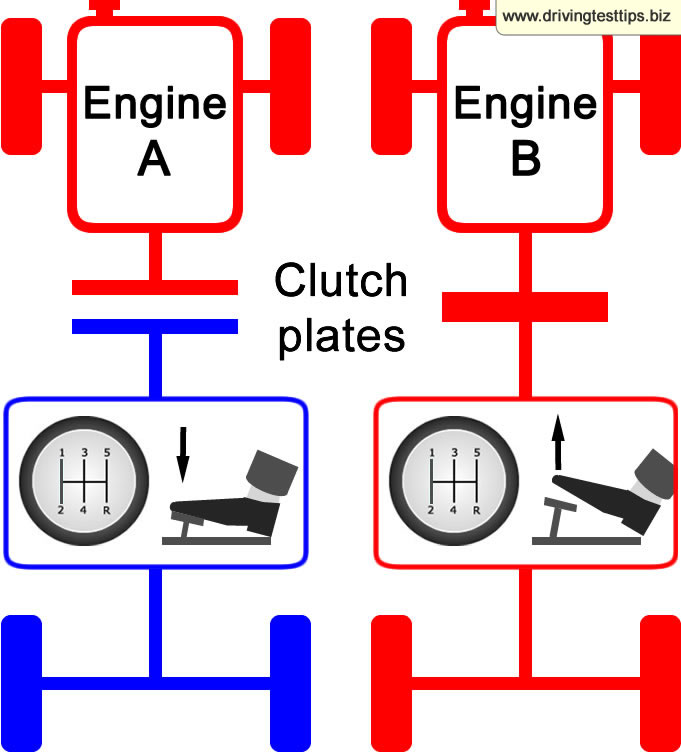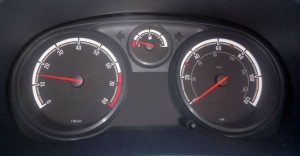It is common for learner drivers to stall the car when either moving off or stalling when stopping the car during the driving test.
Stalling the car on a driving test can result from no fault recorded at all to as much as a serious fault. As driving instructors, we are often asked by learners, ‘Can you fail a driving test for stalling stalling the car?
If you stall during a driving test and whether it impacts the outcome is determined by the frequency in which you stall, how you recover and how it impacts on other road users or pedestrians.
So to take a typical scenario on the driving test, a learner driver is asked to pull up on the left, when they have completed this successfully, they are asked to move off when they are ready. This tutorial offers a guide on how to stop stalling a car.
Clutch bite point to prevent stalling
In order to stop stalling the car, a basic understanding of how the clutch works is needed. The diagram below provides a simple explanation of how the clutch works in a car.
- Engine A has the clutch pedal depressed. This causes the clutch plates to separate which in turn disengages the engine from the gearbox allowing you to change gear. You can depress the clutch pedal as quickly as you wish.
- Engine B has the clutch pedal fully released which in return joins the clutch plates and making a connection from the gearbox to the engine. When the clutch pedal is brought up too fast, it causes the plates to slam together abruptly which it when you stall the car. Bringing the clutch pedal up slowly allows the plates to join smoothly which allows the car to pull away.

When the learner tries to move off, the car stalls but has not moved any distance. This can be due to the car being in the incorrect gear, releasing the handbrake too late or being too aggressive with the clutch.
This may possibly be recorded as a single minor fault by the examiner, or it may not be recorded as any fault at all. It hasn’t affected any other road users so it’s really down to the discretion of the examiner. Stalling in this manor during the driving test isn’t likely to get you into too much trouble although excessive stalling, even if it isn’t affecting other road users may result in a fail due to lack of control of the vehicle.
A more serious example can be the learner is waiting in the middle of a crossroads for oncoming traffic to pass so as they can turn right. When all clear, they attempt to move off but stall the car. The learner flusters around and causes a potential dangerous situation for other road users. Stalling the car in this situation is much more likely to incur a serious fault.
Top Tips on How to stop stalling a car
This technique is used by some driving instructors to help prevent stalling the car when moving off. Let’s assume you are in the car, ready to go with the engine started, handbrake on and of course your seat belt on.
- Depress the clutch fully
- Select first gear
- Set the gas – press the accelerator slowly and gently until you have around 1500 revs on the rev counter and keep the revs in this area
- Find the clutch bite point. (See diagram above) Lift the clutch up very slowly until you hear the engine revs lower. The front of the car may lift slightly and you may hear some creaks as the car tries to move. Remember, the car can’t move at this time as the handbrake is on. If the car is creaking or making groaning noises, depress the clutch slightly around a £1 coin thickness
- Release the handbrake. When you release the handbrake the car may start to move forward slowly or it may remain stationary. Either way, ever so slowly, begin to lift the clutch to allow the car to gain speed. Keep raising the clutch slowly for around 3 seconds or so and then ensure the clutch is fully raised
Although this technique is effective in preventing stalling, it is ultimately a rather cumbersome and difficult way of driving if using this technique every time you move the car off. This technique also drastically increases wear on the clutch, shortening it’s life. The above technique is excellent for a novice driver to gain an understanding of clutch control and to prevent stalling the car.
As a experienced driver however, it is really only needed if you need to move the car off from a upward gradient. Once you have mastered this technique, move on to a better technique which in the long run is easier and much easier on the clutch.
This technique is very similar to the above, but is a much more natural way of allowing the car to move off. The key is to break it down into stages and to not try it all as one movement. This technique needs practicing very slowly and breaking it down into stages until it becomes a natural and fluid process. As above, this assumes the car engine is running, handbrake and seat belt on.
- Depress the clutch fully
- Select first gear
- Set the gas as above
- Slowly start to raise the clutch
- Before the clutch reaches its bite point, release the handbrake
- The car will naturally start to move now as the handbrake isn’t on. Ensure that at the point when the car starts to move, you are very gentle with the clutch and raise it extremely slowly
- After 2 or 3 seconds when the car has gained momentum, the clutch can be raised faster until fully raised
How to move off quickly in a car
Drivers will often need to move the car off quickly when moving off from busy roundabout or junctions. These circumstances are when a learner driver is at most risk of stalling the car. To move a car off quickly, use the above technique, except just before you intend on moving off, supply more gas/revs.
The more power/revs you provide, the faster you are able to bring the clutch up. The faster you bring the clutch up, the faster you can move off and as you have provided more power, you will not stall. Be careful not to be too heavy on the gas and bring the clutch up too fast as it may result in the wheels spinning.
Stalling the car when coming to a stop
It’s important that you find the correct time to depress the clutch before stopping the car. Generally, if you are moving the car very slowly in first gear, the clutch is depressed first, followed by the brake. Anything faster, the brake must be used first, followed by the clutch.
When driving normally and you need to brake to a stop, use the brake initially and depress the clutch around 3 to 4 metres from where the car will stop. This can be done in any gear and at any speed. Depressing the clutch too much later than 3 to 4 metres, especially if in a higher gear such as 5th, is likely to result in the car stalling.
Coasting
Depressing the clutch too early or leaving the clutch down whilst making left or right turns is called coasting. Coasting essentially decreases the cars ability to brake. Whilst braking without the clutch depressed, the car uses the engine to help slow it down as well as the brakes.
If the clutch is depressed, the engine is disengaged from the drive wheels, therefor only the brakes have an effect. Excessive coasting can be dangerous and during the driving test can lead to a failure if done excessively. Further information on coasting and the impact it has on driving and driving tests can be obtained in the What is coasting article.
Recovering from a stall
If you stall during a driving test try not to panic. The examiner simply wants to see you get going again in as little time as possible, but more importantly in a safe manor. If stalling at any time whilst the car is in first gear, there is no need to put the gear stick into neutral. Leave the car in first, ensure you keep the clutch depressed and apply the handbrake. Re-start the car and off you go. If stalling in reverse whilst manoeuvring, again leave the car in reverse, apply the handbrake to secure the car and re-start. If the car stalls in any other gear, apply the handbrake and select neutral.
Rev counter – set the gas
The photo represents the dials in front of the driver in a typical car. The dial on the left is the rev counter and the dial on the right is the speedometer. Set the gas (accelerator) so it reads around 1500 rpm on the rev counter. By giving your engine power in this way before bringing the clutch up will help to prevent stalling the car.

Using these techniques
Try these techniques in a quiet area so you will feel less stressed from other road users. The key is to taking it in stages and slowly until you build up confidence.
Good braking techniques such as progressive braking makes for safer driving, and reduces wear on braking systems and tyres. As it enables you to keep better control of the car, it can help in preventing the car from stalling.
Stop car stalling related guides
Below are guides and tutorials related to the cars clutch that may also help with stalling the car prevention.
- Car clutch
- Slipping the clutch
- Clutch control
- Clutch bite point
- Ride the clutch
- What is coasting
- Wheel spin

thank you very much it helps me a lot now I understand , why my car use to stall.
Iam getting panic when approaching upward signal points., Iam not able to restart on time 😭